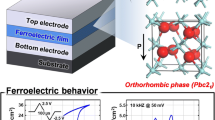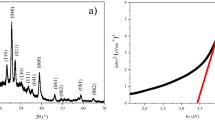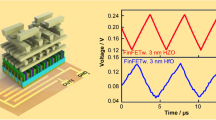Abstract
In the current work, Polarity controllable–Ion Sensitive FET (PC-ISFET) has been proposed that can work as a pH sensor in both n- and p- modes. The approach utilizes self-consistent solution of physics-based model and TCAD simulation. The surface charge density developed at the interface of electrolyte/sensing dielectric has been modeled using Gouy-Chapman-Stern model and Site-binding theory. The sensing efficacy of the proposed sensor has been exhaustively examined in terms of transfer characteristics and various sensitivity parameters such as shift in threshold voltage, drain current, ION / IOFF and transconductance have been critically assessed. Further, the sensing performance has also been analyzed for different high-κ dielectric materials such as HfO2 and Al2O3. It has been demonstrated that HfO2 performs better than Al2O3, although, both HfO2 and Al2O3 exhibit average threshold voltage sensitivity values of 98.47 (94.02) mV/ pH and 83.75 (87.75) mV/pH respectively for n- (p-) mode which is much higher than traditional Nernst limit i.e., 59 mV/pH.
Similar content being viewed by others
Availability of Data and Material
The manuscript has no associated data.
Code Availability
Not applicable.
References
Poghossian A (2014) Schöning M J Label-Free Sensing of Biomolecules with Field-Effect Devices for Clinical Applications. Electroanalysis 26:1197–1213. https://doi.org/10.1002/elan.201400073
Singh L, Zhu G, Singh R, Zhang B, Wang W, Kaushik BK, Kumara S (2020) Gold nanoparticles and Uricase Functionalized Tapered Fiber Sensor for Uric Acid Detection. IEEE Sens J 20:219–226. https://doi.org/10.1109/JSEN.2019.2942388
Singh L, Singh R, Zhang B, Cheng S, Kaushik BK, Kumara S (2019) LSPR based Uric Acid Sensor using Graphene Oxide and Gold Nanoparticles Functionalized Tapered Fiber. Opt Fiber Technol 53:102043. https://doi.org/10.1016/j.yofte.2019.102043
Bergveld P (1970) Development of an ion-sensitive solid-state device for neurophysiological measurements. IEEE Trans Biomed Eng 17:70–71. https://doi.org/10.1109/TBME.1970.4502688
Bergveld P (1972) Development, operation, and application of the ion-sensitive field-effect transistor as a tool for electrophysiology IEEE Trans. Biomed Eng 19:342–351. https://doi.org/10.1109/TBME.1972.324137
Wang Y, Yang M, Wu C (2020) Design and implementation of a pH sensor for micro solution based on nanostructured ion-sensitive field-effect transistor. Sensors 20:6921. https://doi.org/10.3390/s20236921
Van Ha REG, Eijkel JCT, Bergveld P (1996) A general model to describe the electrostatic potential at electrolyte oxide interfaces Adv. Colloid Interface Sci 69:31–62. https://doi.org/10.1016/S0001-8686(96)00307-7
Bergveld P (2016) The development and application of FET-based biosensors. Biosensors 2:15–33. https://doi.org/10.1016/0265-928X(86)85010-6
Parizi KB, Xu X, Pal A, Hu X, Wong HSP (2017) ISFET pH Sensitivity: counter-ions play a key role. Sci Rep 7:41305. https://doi.org/10.1038/srep41305
Heinzig A, Slesazeck S, Kreupl F, Mikolajick T, Weber WM (2011) Reconfigurable silicon nanowire transistors. Nano Lett 12:119–124. https://doi.org/10.1021/nl203094h
Heinzig A, Mikolajick T, Trommer J, Grim D, Weber WM (2013) Dually active silicon nanowire transistors and circuits with equal electron and hole transport. Nano Lett 13:4176. https://doi.org/10.1021/nl401826u
Marchi M D, Sacchetto D, Frache S, Zhang J, Gaillardon P E, Leblebici Y , Micheli G D (2012) Polarity control in double-gate, gate-all-around vertically stacked silicon nanowire FETs IEEE-IEDM 183. https://doi.org/10.1109/IEDM.2012.6479004
Larson JM, Snyder JP (2006) Overview and status of metal S/D schottky barrier MOSFET technology. IEEE Trans Electron Devices 53:1048–1058. https://doi.org/10.1109/TED.2006.871842
Ashcroft B, Takulapalli B, Yang J, Laws GM, Zhang HQ, Tao NJ, Lindsay S, Gust D, Thornton TJ (2004) Calibration of a pH sensitive buried channel silicon-on-insulator MOSFET for sensor applications. Phys Stat Sol 241:2291–2296. https://doi.org/10.1002/pssb.200404936
Khanna VK (2007) pH measurement of dirty water sources by ISFET: addressing practical problems. Sensors Review 27:233–238. https://doi.org/10.1108/02602280710758183
ReddyJr B, Dorvel BR, Go J, Nair PR, Elibol OH, Credo GM, Daniels JS, Chow EKC, Su X, Varma M, Alam MA, Bashir R (2011) High-k dielectric Al2O3 nanowire and nanoplate field effect sensors for improved pH sensing. Biomed Microdevices 13:335–344. https://doi.org/10.1007/s10544-010-9497-z
Chen S, Bomer JG, Carlen ET, Berg A (2011) Al2O3/silicon nanoISFET with near ideal nernstian response. Nano Lett 11:2334–2341. https://doi.org/10.1021/nl200623n
Jang H-JJ, Cho W-JJ (2012) Fabrication of high-performance fully depleted silicon-on-insulator based dual-gate ion-sensitive field-effect transistor beyond the Nernstian limit. Appl Phys Lett 100:073701. https://doi.org/10.1063/1.3685497
Abdolkader TM (2016) A numerical simulation tool for nanoscale ion-sensitive field-effect transistor. Int J Numerical Modell Electron Netw Devices Fields 29:1118–1128. https://doi.org/10.1002/jnm.2170
Bandiziol A, Palestri P, Pittino F, Esseni D, Selmi L (2015) A TCAD based methodology to model the site-binding charge at ISFET/electrolyte interfaces. IEEE Trans Electron Devices 62:3379. https://doi.org/10.1109/TED.2015.2464251
Mohammadi E, Manavizadeh N (2018) An Accurate TCAD-Based Model for ISFET Simulation. IEEE Trans Electron Devices 65:3950–3956. https://doi.org/10.1109/TED.2018.2857218
Pittino F, Palestri P, Scarbolo P, Esseni D, Selmi L (2014) Models for the use of commercial TCAD in the analysis of silicon-based integrated biosensors. Solid-State Electron 98:63–69. https://doi.org/10.1016/j.sse.2014.04.011
Choi B, Lee J, Yoon J, Ahn JH, Park TJ, Kim DM, Kim DH, Choi SJ (2015) TCAD-based simulation method for the electrolyte insulator-semiconductor field-effect transistor. IEEE Trans Electron Devices 62:1072. https://doi.org/10.1109/TED.2015.2395875
Kalra S, Kumar MJ, Dhawan A (2020) Reconfigurable FET biosensor for a wide detection range and electrostatically tunable sensing response. IEEE Sensors J 20:2261–2269. https://doi.org/10.1109/JSEN.2019.2952333
Saha P, Dash DK, Sarkar SK (2019) Nanowire reconfigurable FET as biosensor: Based on dielectric modulation approach. Solid-State Electron 161:107637. https://doi.org/10.1016/j.sse.2019.107637
Simon M, Heinzig A, Trommer J, Baldauf T, Mikolajick T, Weber WM (2017) Top-down technology for reconfigurable nanowire FETs with symmetric on-currents. IEEE Trans Nanotechnol 16:812–819. https://doi.org/10.1109/TNANO.2017.2694969
Simon M, Liang B, Fischer D, Knaut M, Than A, Mikolajick T, Weber WM (2020) Top-down fabricated reconfigurable FET with two symmetric and high-current on-states. IEEE Electron Device Lett 41:1110–1113. https://doi.org/10.1109/LED.2020.2997319
ATLAS: 2-D Device Simulator, Version5.19.20.R, Silvaco, Santa Clara, CA, USA, 2014
Chung I-Y, Jang H, Lee J, Moon H, Seo SM, Kim DH (2012) Simulation study on discrete charge effects of SiNW biosensors according to bound target position using a 3D TCAD simulator. Nanotechnology 23:065202. https://doi.org/10.1088/0957-4484/23/6/065202
Yates DE, Levine S, Healy TW (1974) Site-binding model of the electrical double layer at the oxide/water interface. J Chem Soc Faraday Trans 1 70:1807–1818. https://doi.org/10.1039/F19747001807
Bousse L, Rooij N De, Bergveld P (1983) Operation of chemically sensitive field-effect sensors as a function of the insulator-electrolyte interface IEEE Trans. Electron Devices 30. https://doi.org/10.1109/T-ED.1983.21284
Landheer D, Aers G, McKinnon WR (2005) Model for the field effect from layers of biological macromolecules on the gates of metal-oxide-semiconductor transistors. J Appl Phys 98:044701. https://doi.org/10.1063/1.2008354
Tarasov A, Wipf M, Stoop RL, Bedner K, Fu W, Guzenko VA, Knopfmacher O, Calame M, Schonenberger C (2012) Understanding the electrolyte background for biochemical sensing with ion-sensitive field-effect transistors. ACS Nano 6:9291–9298. https://doi.org/10.1021/nn303795r
Acknowledgements
The authors (Priyanka Pandey) are thankful to the University Grants Commission, Government of India (3631/(NET-NOV (2017))) for providing necessary financial assistance during the course of research work. The authors also acknowledge Faculty Research Programme Grant – IoE (IoE/FRP/PCMS/2020/27).
Funding
The authors (Priyanka Pandey) are thankful to the University Grants Commission, Government of India (3631/(NET-NOV (2017))) for providing necessary financial assistance during the course of research work. The authors also acknowledge Faculty Research Programme Grant – IoE (IoE/FRP/PCMS/2020/27).
Author information
Authors and Affiliations
Contributions
The authors have contributed equally.
Corresponding author
Ethics declarations
Ethics Approval
The authors have followed the ethical standards.
Consent to Participate
All the authors have complete consent to participate.
Consent for Publication
All the authors have complete consent for publication.
Conflicts of Interest
There is no conflict of interest.
Additional information
Publisher's Note
Springer Nature remains neutral with regard to jurisdictional claims in published maps and institutional affiliations.
Rights and permissions
About this article
Cite this article
Pandey, P., Kaur, H. Performance and Sensitivity Analysis of Polarity Controllable-Ion Sensitive FET for pH Sensing Applications. Silicon 14, 8467–8474 (2022). https://doi.org/10.1007/s12633-022-01658-y
Received:
Accepted:
Published:
Issue Date:
DOI: https://doi.org/10.1007/s12633-022-01658-y




